|
|
|
|
November December Continues More Ramblings
December 4, 2000:
Philippines: With tons of "Hey
Joe"s and "Hey Man"s, and even an occasional "What's
up Doc?", the old American presence (US military gone since
1997) is apparent in Manila. While walking through some back
streets, in a vane attempt to find the Chinese cemetery, a small
child no more than four-years-old cruised by Bruce and I, slapping
Bruce a high (or rather low) five as he passed. Everywhere boys
were playing basketball. And many of the thousands of Jeepneys
(extended jeep come taxis) bore NBA stickers and US flags along
side their "God Bless"s and "Jesus Loves You"s.
A heavy down-pour had just stopped and dirt covered everything,
garbage clinging to the sides of flooded streets. Grabbing a
cab we headed for another part of the city, the Spanish Quarter
of Intramuros. The US influence changed somewhat with MacDonalds
and Kentucky Fried Chickens lining the roads, the dirt, however,
didn't change, and was still clinging to just about everything.
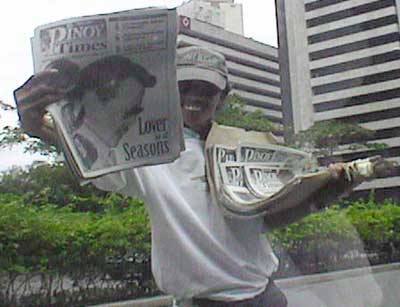
(With their president, or
'Lover of all Seasons' Joseph Estrada, going into impeachment
hearings in four days, the Philippines seem fairly calm, no million
man marches in the capital or all-country work stops for several
days now.)
We were lucky to pick a spot fairly central for our out-of-his-mind
taxi driver -- who wove in and out of traffic with the temperament
of a Japanese Kamakazi. Rizal Park at the southern end of Intramoros
was pack full of Filipinos. There was a festival going on, which
wasn't surprising as there is a festival going on every day somewhere
in these islands. The party was a celebration of all the different
ethnic groups in the Philippines. In the muddy park barely-clad
men with large head pieces killed chickens and little ladies
preformed demon-expelling dances. We left before the main stage
began, filled with, no doubt, lots of ethnic dancing to loud
Filipino bands.
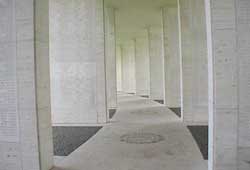
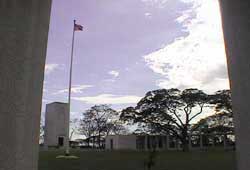
(With more than
15,000 soldiers commemorated this US memorial is the largest
outside of America. Along with missing US servicemen, many of
the missing Filipino soldiers appear on the marble walls.)
Marys and Mangers and Kris Kringles and Creches cover everything
in Manila. Christmas is here and the playing of holiday jingles
is only going to increase. With just 21 days till the big day
life in the Makati district is nothing but shopping (although
I get the feeling that that is the usual feeling here). Ending
up at a large mall to find some things for dinner, most every
product you'd want was available in the basement grocery -- another
aspect of American influence. What a change from the grunge-filled
alleys of earlier in the day.
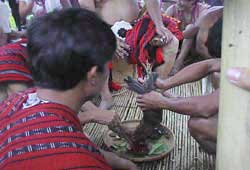
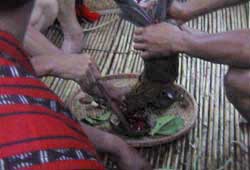
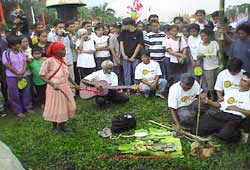
(Sacrificed chickens
and exorcised demons are scattered around throughout Rizal park,
products of a large exhibition of Filipino indigenous people.)
December 11, 2000:
Cambodia: The flight touched
down shortly after ten o'clock in the morning. I pulled myself
up off the seat and rubbed my ears -- coming off of an ear infection,
the sound of my seat mate, a two-year-old boy, brought me to
near deafness. I grabbed my bag and followed the load of passengers
being herded off the plane, down steps and into an old school
bus, circa 1950 I'm sure. I crawled to the back of the bus, not
quite bringing myself to sit down next to any of the older men
who were holding most of the two-seat benches hostage and glaring
at me as I plodded past them. I sat down just as the bus pulled
away only to stop 300-yards later at the International Terminal
of the Phnom Penh airport.
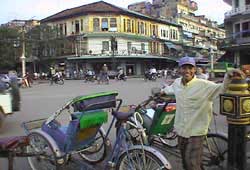
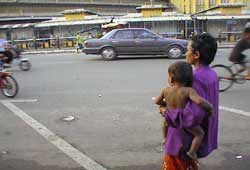
I sat waiting for the bus to clear out a little. "Are
you getting off here?" Asked the small Cambodian girl in
three-inch soled shoes and a mini-skirt. "Whaaaa?"
I replied, my ears still ringing from the loud goodbyes the two-year-old's
parents insisted he give me after the plane landed. Understanding
what the girl intended, I nodded yes and smiled. Well, isn't
everyone getting off here? I thought. Then again, the idea
of the bus making only a quick stop here before heading on to
some other destination on the other side of the city was not
at all uncomprehensible; anything goes, they say of Phnom Penh.
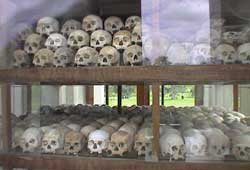
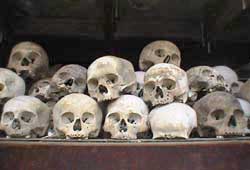
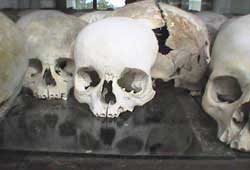
Breezing through customs my friend Bill and I grabbed a taxi
to Bill's brother Andy's place. Andy, who moved to Cambodia just
a few weeks ago, is doing some work on a Hepatitis B vaccination
program. Lucky for Bill and I that his post began when it did.
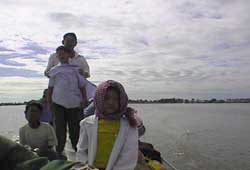
Later in the day Bill and I went out for a walk, I wanted
to get the lay of the city outlined in my mind. We ambled up
cracked cement roads, moto drivers whizzing by, to the shore
of the Mekong river. A loud ceremony was rattling on a few meters
down the riverside. Khmers wondered about carrying lotus buds
and incense, dirty children and beggars asked for money. Milling
around for a few minutes, we couldn't figure out what the celebration
was for. It was a holiday in Cambodia, I knew that -- Andy had
told us earlier that National Human Rights Day, which was yesterday,
was being observed today -- but I couldn't believe that all this
devotion, this praying and music, would be in honor of a celebration
so hypocritical it begs no clarifacation (see: Human Rights Record
for Cambodia '00 if you don't get it). And of course later in
the night Bill and I figured out that yes, it was a big celebration
(as opposed to the idea that this is the way every Monday is
in Phnom Penh). As we walked back past the little stupa a big
fat moon rose in the background -- it was a Buddhist full-moon
festival. I slapped my forehead, of course, I thought.
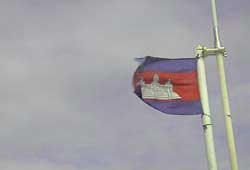
December 14, 2000:
Siem could remember her family running from Phnom Penh when
she was five-years-old. The regime of Pol Pot and the Khmer Rouge
drove nearly everyone from the Cambodian capital, a relative
ghost town for the next four years (1975 - 1979). After her family
-- mother, father, two brothers and sister -- reached the new
village they were to live in near the Vietnamese border, her
brothers and father were taken away to be re-educated. "That
means that they were taken away and killed." Explained Siem.
Soon after her mother died and she and her sister were sent to
different orphanages. Many years later, scraping enough money
to venture back to her hometown of Phnom Penh, Siem worked odd
jobs -- making juice, cleaning homes -- and attended free English
lessons held in town. After gaining a sufficient knowledge of
the language, Siem went to work at the old S-21 prison camp turned
museum. The prison had held over 20,000 inmates within those
four years, only seven of them survived.
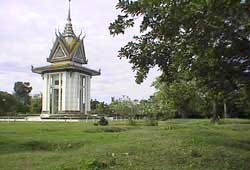
It was at S-21 that I met Siem. She gave a quick tour through
the prison grounds, explaining in quick and quiet English how
people were tortured to death: "by electric shock here"
or "starvation there" or "suffocating in a bucket
of feces there." Blood still stained the tile floors, nothing
having been changed since the Vietnamese over-ran the city and
liberated the prison in 1979. Pictures of the prisoners hung
on the walls of one of the buildings. The KR documented everything
that went on within the prison grounds. Before and after pictures
showed the cruelty and horror that embodied those four years.
An estimated count has more than two-million people killed by
the Pol Pot regime, over 1/3 of the then Cambodian population
of six-million. Siem described the tales of the seven lone survivors
and became more and more quiet. While we walked back to the main
gate I asked her a few questions, discovering her history. "I've
worked here for three years, " she said to me. And then,
more to herself, she added, "and still I remember, I cannot
forget."
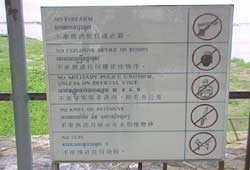
I had spent that morning out at the Cham Ek Genocidal Center,
better known as the "Killing Fields", where over 9,000
of those 20,000 people were brought, killed and thrown into mass
graves. The whole day was more than depressing. After I learned
from Siem that a few of the men who served on Pol Pot's government
were still working within the present Cambodian government --
having never been prosecuted for their involment in the state-wide
genocide -- I ceased trying to make sense of Cambodia, her gruesome
past or her present.
It is a testament to the Cambodian people that some 20-odd
years after nearly all their educated citizens were killed --
doctors, lawyers, artists, anyone who spoke foreign languages
-- that they are doing so well: English being spoken in all major
cities and schools open in every village. Cambodians, as a people
have always valued education, their traditional way of life and
remaining ruins attest to this. Leaving the prison Bill turned
to me and told me about some graffiti he saw on the inside of
the prison. He said, "I couldn't tell if the simple math
equation I saw scratched into the wall was left by a student
of the high school before the building was turned into a prison,
or if it was from a prisoner as a way of saying 'I am educated.
This much I know.'"
|
|






